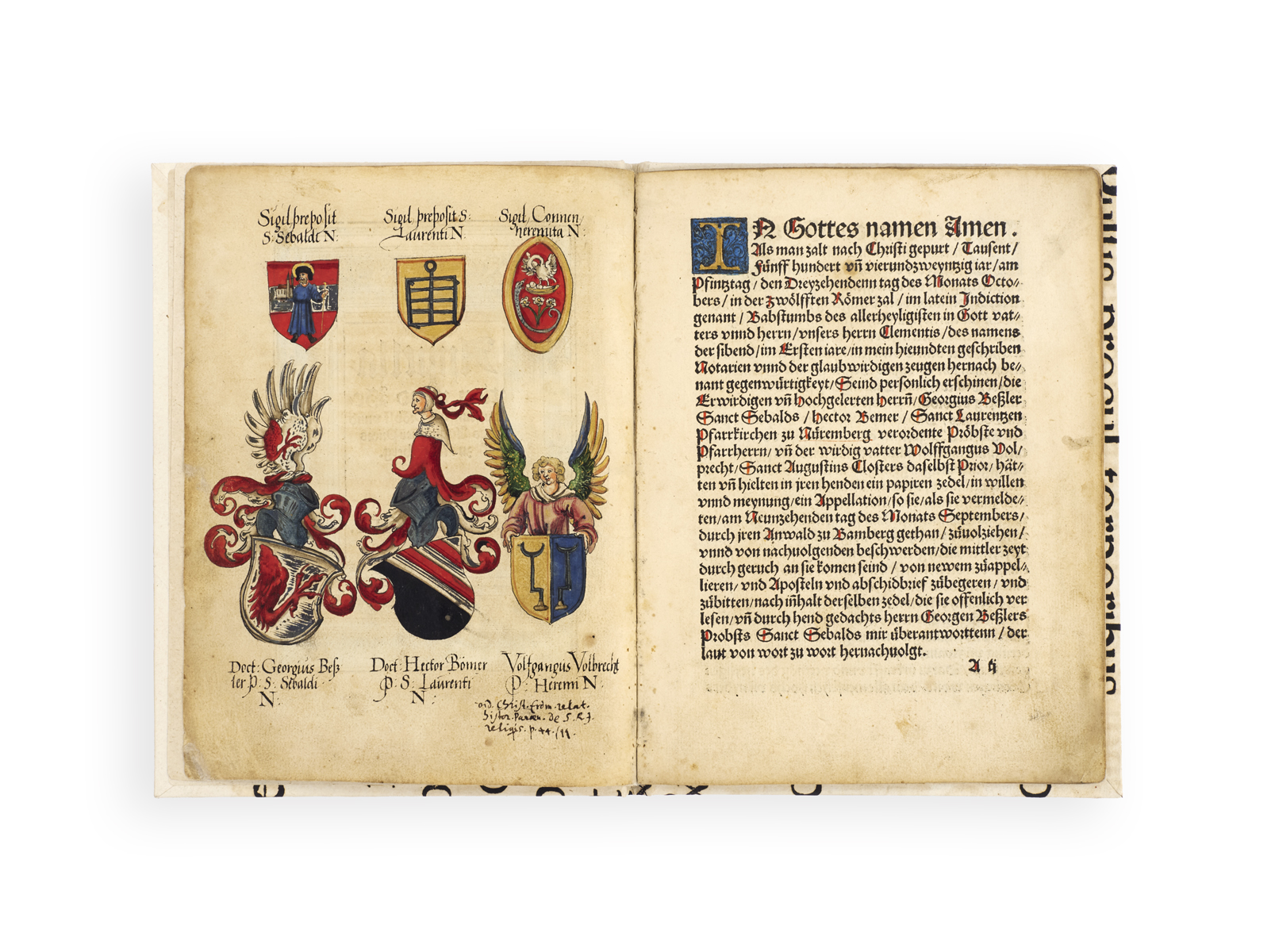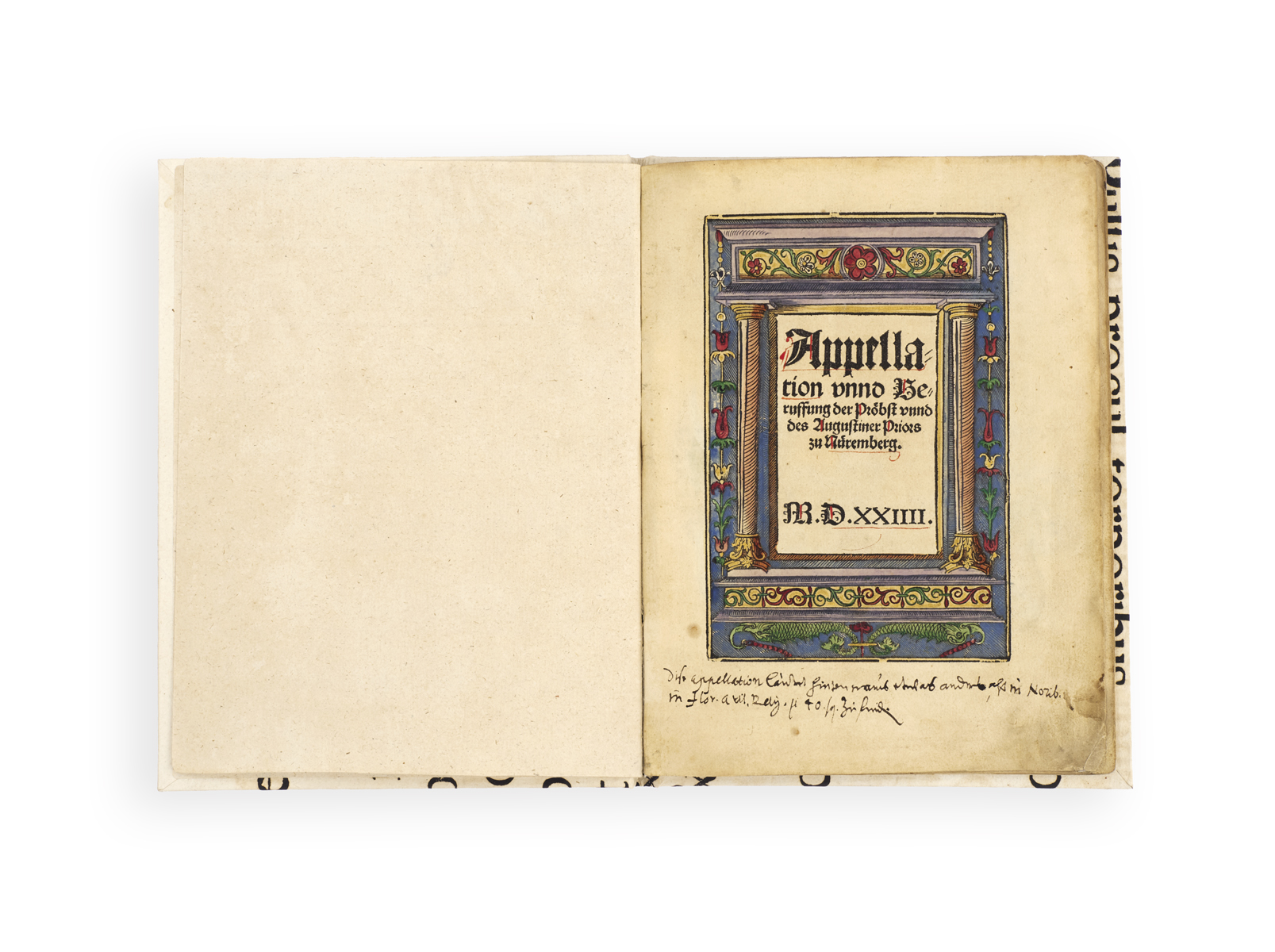


LUTHERAN PROVOSTS APPEALING THEIR EXCOMMUNICATION
[BESLER, Georg, Hector PÖMER, and Wolfgang VOLPRECHT.]
Appellation unnd Beruffung der Pröbst unnd des Augustiner Priors zu Nüremberg.
[Nuremberg, Friedrich Peypus,] 1524.
4to, pp. [14], [2 (blank)]; title within architectural woodcut border, 3-line woodcut initials, contemporary rubrication to capitals; subtle repair to lower outer corner of title, marginal toning and spotting, some offsetting to final blank leaf; a very good copy in a recent binding reusing a seventeenth-century printed breviary leaf; contemporary underlining to 3 pp. in red and black, contemporary notes in German to title (‘Dise Appellation… hinten … in Norīb …’) and in Latin to verso (‘Ord. Christ … relat. History. … de S.R.J. reliquis. p. 44’), mid-sixteenth-century illumination and hand-colouring to title in green and red against a blue background, initials illuminated and hand-coloured in blue and red-violet, title-page verso with hand-drawn arms of Besler, Pömer, and Volbrecht and the seals of their churches coloured in red, black, blue, green, and yellow, all of which labelled in a sixteenth-century calligraphic hand (see below).

Added to your basket:
Appellation unnd Beruffung der Pröbst unnd des Augustiner Priors zu Nüremberg.
First and only edition of this pamphlet by the Lutheran provosts and Augustinian prior of Nuremberg, appealing Bishop Weigand von Redwitz’s ruling to excommunicate them as heretics, with magnificent near-contemporary hand-painted and illuminated illustrations of the defendants’ arms.
Georg Besler (or Pesler, 1470–1536) and Hector Pömer (or Bömer, 1495–1541) had both studied at Wittenberg and were dedicated followers of Luther; the Nuremberg city council, increasingly swayed by the cause of reform, named them provosts at the parish churches of Saint Sebald and Saint Lorenz, respectively. In April 1524, the two provosts and Wolfang Volprecht (d. 1528), the prior of the city’s Augustinian monastery, had ‘administered communion in both kinds … The provosts went even further by abolishing requiems and birthdays in honour of the saints, Masses for the dead, singing of the “Salve regina” in honor of the Virgin Mary, and consecrating salt and water’ (Grimm, pp. 73-4). Following the refusal of the prior and provosts to revert to the old ceremonies per the bishop of Bamberg’s demands, claiming that they were contrary to Scripture, they were called to the episcopal court, in which the bishop himself acted as judge; on 19 September 1524 he ruled that the three men be stripped of their titles and excommunicated under charges of heresy.
The Appellation unnd Beruffung, jointly compiled by Besler, Pömer, and Volbrecht, represents their appeal against the bishop’s verdict as submitted to the episcopal notary, in which they seek a ‘justification of the injustice and ignorance of the judge’ (A2v, trans.) through the rectification of his conflict of interest and a revised ruling grounded in Scripture. Printed by Friedrich Peypus, who published several of Luther’s works and material on the Diets of Nuremberg, the appeal was submitted to the city council; von Redwitz’s ruling was openly disregarded and the provosts taken under the city’s protection, a sign of the bishop’s dwindling influence in Nuremberg.
Our copy has been richly embellished by a mid-sixteenth century artist, who has illustrated and illuminated the arms of Besler, Pömer, and Volprecht and the corresponding seals of their respective churches, labelling the six illustrations in a handsome calligraphic hand. The year after the appeal was issued, the Augustinian monastery was turned over to the city council, and Volprecht took up a role as priest at the city’s Heilig-Geist-Spital; an early inscription beneath his arms notes that the church was a repository for Imperial relics (which were kept there from 1433 to 1796). The care with which the arms were executed, as well as the early underlining of all mentions of Nuremberg within the text, suggests local ownership.
Scarce outside Germany. We find two copies in the UK (BL, Bodley) and three in the US (University of Maine, Yale, United Lutheran Seminary).
BM STC German, p. 81; USTC 612622; VD16 B-2234; Kuczyński 16, p. 11; Panzer II 2402.
See Grimm, ‘The Break with Rome’, in Lazarus Spengler: A Lay Leader of the Reformation (1978), pp. 73-92.
